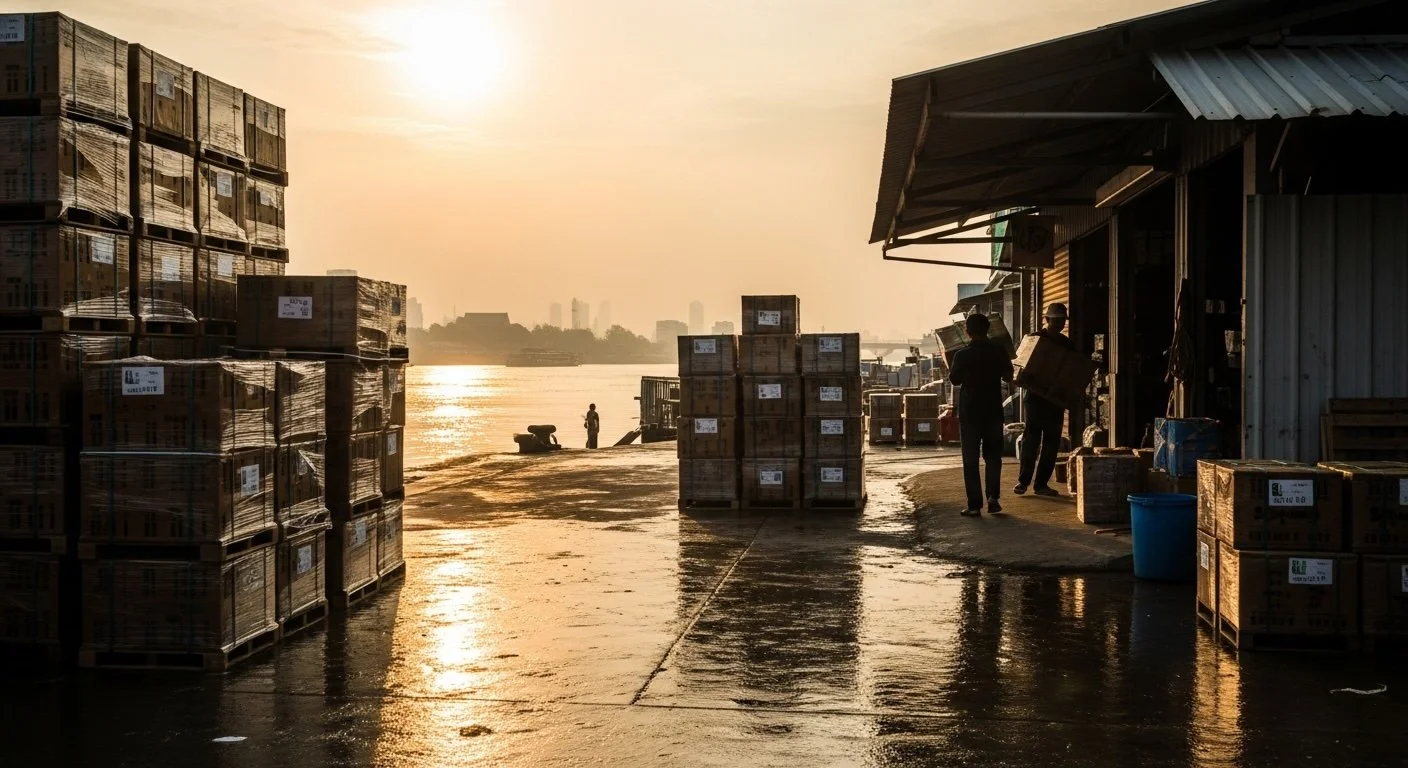Thailand’s Sanctions Blind Spot: Why Enforcement in Bangkok’s Financial Hubs Is About to Get a Lot Harder
The Chao Phraya River, Bangkok's historic trade artery.
Thailand has long been celebrated as the launch-pad of Southeast Asia: vibrant tourism, growing digital finance, fast-moving cross-border trade and remittances. But beneath the buffet of “financial gateway” lies a structural tension that many compliance teams in Bangkok, Chiang Mai and beyond are only now waking up to: sanctions risk that isn’t simply ticking a box — it’s bleeding in through multiple corridors simultaneously.
This is not about Thailand changing the rules. It’s about the world around Thailand changing — and the Thai system now being forced to adapt accordingly.
Three particular corridors expose this shift: the Myanmar military economy, Russia and its downstream flows, and the scam-compound/mule-account economy that threads through the Thai-Myanmar borderlands. Each of these is live, real-time, and increasingly visible to the world’s major regulators.
Case Study 1: The Myanmar Corridor — From Trade Partner to Sanctions Exposure
Thailand’s proximity to Myanmar isn’t simply geographic. It’s structural. Several reports now show that Thai-registered companies and Thai-banking corridors are being used by the Myanmar junta’s procurement network. In the UN’s Human Rights Report 2024 it is stated that payments worth US $120 million in 2023 were routed through Thailand for Myanmar’s military-linked purchases — double the previous year.
Trade along Thailand’s river corridors is the lifeblood of regional commerce—and one of the least visible fronts in rising sanctions and AML pressure from Myanmar, Russia, and beyond.
Thai banks admitted to the parliamentary committee that while they complied with regulations, they lacked capacity to investigate the full breadth of ‘indirect’ transactions used for weapons or dual-use goods.
In response, on 30 December 2024 the Anti‑Money Laundering Office (AMLO) and the Bank of Thailand (BOT) issued a joint statement emphasising that Thai institutions must now treat high-risk country flows (including Myanmar) as a sanctions-related risk, with rigorous UBO checks, dual-use screening and heightened monitoring.
Why this matters for Thai institutions: If a client pays for goods from a Myanmar entity that is under sanctions (even indirectly), the Thai bank or payment firm may be exposed to secondary sanctions risk. The naming conventions and corporate structures are opaque, meaning traditional screening can fail.
Case Study 2: Russia’s Flow Through Thailand — A Hidden Transit Risk
Thailand may not impose sanctions on Russia, but that does not mean Thai financial institutions are immune. Russian capital has increasingly taken advantage of corridors through Bangkok, Phuket and the Eastern Economic Corridor — via high-value property purchases, gold bullion, crypto off-ramps, even luxury tourism spending.
Gold trading in Bangkok's Yaowarat district. When digital payment rails become too visible, value converts to bullion—one of the layering techniques used in the scam-compound economy that moves proceeds through Thai infrastructure before disappearing offshore.
Even though domestic Thai regulations may not specifically target “Russia sanctions”, correspondent banks (especially in the US and EU) expect Thai firms to maintain equivalent standards of screening. Screening failures in Thailand can trigger derisking or relationship termination, even if local regulators do not fine the firm directly.
Key operational insight: Sanctions risk in Thailand is no longer just about ‘who are we dealing with?’ — it’s about how the value is moving, which rails are used, and whether upstream or downstream counterparties are clean.
Amplifying this: the translation of names, the regional languages, the use of crypto, and the latency of detection make Thailand’s digital, cross-border ecosystem especially vulnerable.
Case Study 3: Scam Compounds, Mule Accounts and the Thai Border Risk
The scam-compound phenomenon along Thailand’s northern and western borders has been well documented: forced labour in Myanmar/Laos/Cambodia, online investment fraud, romance scams — all channelled through Thai bank accounts and e-wallets before moving value offshore. In such flows, many of the key actors are subject to UN/UK/US sanctions, particularly when human trafficking, forced criminality or arms supply are involved.
In June 2024 the UN reported that banks in Thailand had become the main suppliers of cross-border financial services to the Myanmar military government — used for revenue and weapons procurement.
The gangster/scam networks don’t operate through nice neat single payments. They use layered transfers: Thai e-wallets, PromptPay, quick cross-border movement, gold conversion, crypto. For a Thai payment firm or fintech, this means that compliance can no longer be about setting thresholds — it must be about real-time detection of anomalous behaviour.
Why this is sanctions risk: If the mule account is controlled (directly or indirectly) by a sanctioned individual, or if proceeds of crime feed a network already flagged by sanctions authorities, then your institution suddenly becomes a nexus point in a geopolitical enforcement issue, not just a fraud incident.
Thailand’s digital payments boom has created new opportunities—and new vulnerabilities. E-wallet agents are now frontline actors in a sanctions environment changing faster than most compliance systems can track.
What This Means for Thai Institutions
Thailand’s regulatory framework is evolving. The regime is no longer just about doing more paperwork — it’s about aligning with how the world expects a modern financial system to behave, especially when it sits at key regional crossroads.
In December 2024 the AMLO and BOT said that all Thai financial institutions must treat transactions with high-risk countries as potential sanctions-related risks — and must accelerate enhanced due diligence (EDD) and UBO scrutiny accordingly.
Thailand’s major laws — the Anti‑Money Laundering Act B.E. 2542 (AMLA) and the Counter‑Terrorism and Proliferation of Weapons of Mass Destruction Financing Act B.E. 2559 (CFTA) — are being amended to reflect evolving global norms.
Sanctions enforcement in Thailand is increasingly about operational rigor: Do you have the screening? Are you verifying UBOs? Do you trace value across unusual rails? Do you monitor high-velocity, multi-leg transactions?
Following the December 2024 AMLO-BOT directive, Thai banks must now treat high-risk country flows as potential sanctions violations—a shift from procedural compliance to active intelligence work.
The Practical Imperatives
For banks, fintechs, mobile money operators, remittance firms and cooperatives in Thailand, the task is clear: move beyond compliance as box-ticking and adopt compliance as intelligence infrastructure.
You need:
Centralised KYC and UBO data you can retrieve at branch or agent level.
Sanctions screening tuned to local languages, transliterations, Asian name-variants.
Monitoring that detects “layering via e-wallet – gold – crypto” rather than just “single transaction above threshold.”
Case-management that allows real-time drill-down into cross-border flows, suspicious rails and network-behaviour anomalies.
Governance processes that link your internal decision-making with global correspondents’ expectations.
Institutions that adopt these will maintain correspondent banking access, avoid operational derisking, preserve reputational trust, and stay ahead of regulation. Those that don’t will find that the standard has been set by others — not by Thailand alone.
The Direction of Travel
Thailand is not stepping behind; it is facing forward into a more demanding landscape. The sanctions risk is not hypothetical. It is tied to real military supply networks, cross-border fraud economies, and digital value flows that loop through Thai rails.
If Thailand wants to maintain its position as a vital financial hub in Southeast Asia, the Thai financial sector must see compliance not as a cost but as a strategic asset.
The institutions that will succeed are those that treat compliance as architecture, not afterthought.
The institutions that maintain correspondent relationships with Western banks now face a choice: implement enhanced due diligence for Myanmar, Russian, and mule-account flows—or risk the operational derisking that has already begun elsewhere in the region.
How Anqa Helps in This Environment
For institutions operating in Thailand, merely having a compliance tool isn’t enough. You need a system built for these specific regional risks.
At Anqa we built our sanctions engine, KYC hub, monitoring framework and risk-scoring system with markets like Thailand in mind: Asian names, multilingual transliterations, high-velocity flows, e-wallet and remittance rails, dual-use goods visibility, and real-time behavioural analytics. (To see how our tools address these risks in practice, book a demo here.)
Final Word
Thailand sits at the gateway of Asia — not just geographically, but financially. That position comes with opportunity and exposure.
Sanctions risk is no longer “out there” in abstract. It is running through Bangkok, Chiang Rai, Mae Sot, Phuket, and across e-wallet rails in seconds.
Institutions that see this and act accordingly will be ahead of the curve. Those that treat it as “business as usual” will wake up to correspondent banks dialing down their relationships, regulators knocking on their doors and value flows freezing overnight.
Thailand’s financial ecosystem needs more than compliance checklists. It needs intelligence, architecture and readiness.






